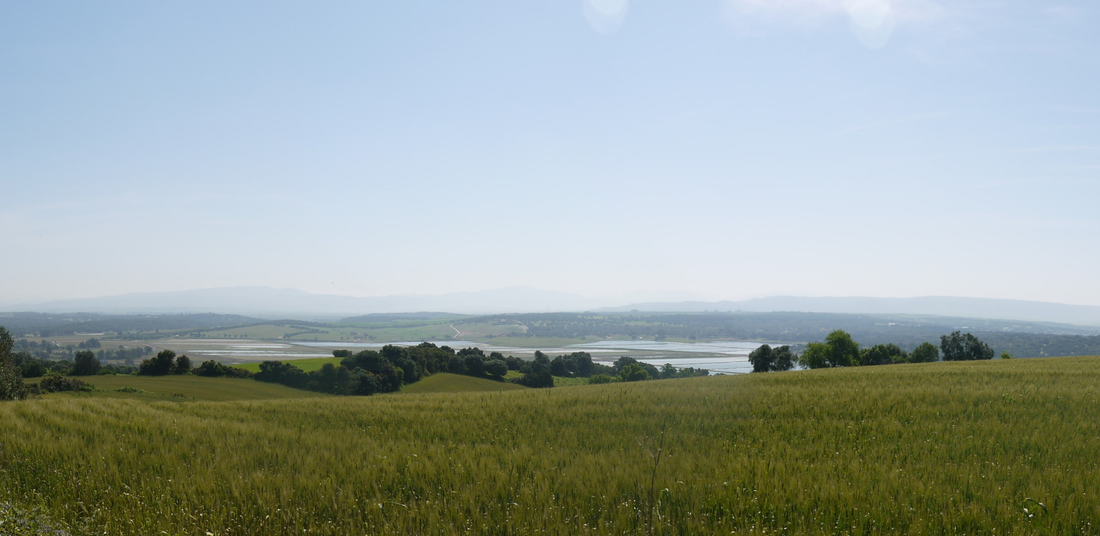 Looking across to the site of Laguna del Torero from near Vejer
Looking across to the site of Laguna del Torero from near Vejer 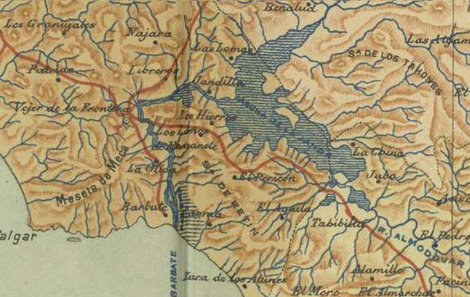 Historic map of La Janda
Historic map of La Janda 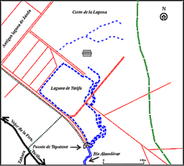
 Global Brid Fair 2022
Global Brid Fair 2022  The logo of the Asociación Amigos de la Laguna de La Janda
The logo of the Asociación Amigos de la Laguna de La Janda | Birding Cadiz Province |
|
 Looking across to the site of Laguna del Torero from near Vejer Looking across to the site of Laguna del Torero from near Vejer It was reading Guy Mountfort’s iconic book “Portrait of a Wilderness” (1958) in the late 1960s that inspired me and a group of friends to first go birding in Spain in 1970. There were no guides back then, no internet and little information about where to see birds beyond the maps in Peterson’s field guide. As a result, the closest thing we had to a site guide in southern Spain was Mountfort’s book but, as I recall, that only mentioned three sites, the Coto itself, Bonanza saltpans and La Janda. Surprisingly we got permission to visit the Coto, but found access to Bonanza saltpans denied by a locked gate and so went in search of the Laguna de la Janda. We knew where to go as it was marked on the cheap roadmaps we’d picked up at petrol stations en route. So it was with some excitement that we headed along the road from Vejer towards Tarifa. When no laguna appeared, we just assumed that, such was the scale of the map, we'd somehow missed it or, perhaps our map reading skills weren’t as good as we thought. In reality, our error was not one of map reading, but of timing as the last remnants of the laguna had disappeared in 1967. I still rather resent the fact that after decades of trying the drain the place, they finally managed it just before I got there! Had we been better informed we’d have still turned off the road and explored the site as even the ghost of the old laguna is good for birds.  Historic map of La Janda Historic map of La Janda The historic maps on the excellent Asociación Amigos de la Laguna de La Janda blog (http://blog.lagunalajanda.org/cartografia/) show that the exact shape and extent of Laguna de la Janda was never fixed but shifted and changed according to the amount of rainfall and by season. These changes could be extensive as the laguna was shallow being no deeper than 3m so rapidly changed shape as the water evaporated or the laguna was fed by rainfall. At its greatest extent Laguna de la Janda may have had a surface of 7,000 hectares but could shrink to around 4,000 hectares. Hence on maps it sometimes it appears as a thin sausage-shape, a lozenge or, at its greatest extent in wet years, a huge boomerang stretching north-east to include Laguna de Espartinas. In fact, in some ways the name Laguna de la Janda is a misnomer as Lagunas de la Janda (as it is sometimes styled) would be more apt since in drier times it became a string of smaller lagunas – Aguila, Rehuelga, Espartinas, Jandilla, Tapatana y la Haba, Tapantanilla and Cabrahigos. I've not found the latter on any map so I've assumed (quite possibly incorrectly) on my map that it's synonymous with Laguna del Hiero which I have found. Laguna de Alcala and Laguna del Torero usually (if not always) seem to have been comparatively isolated outliers . Some of these satellite lagunas were close in size to Laguna de Medina so must have been impressive sites for wildlife in their own right. Today the Rio Barbate (with a minor road beside it) still squeezes between two low hills just east of Vejer before opening out at the site of Laguna del Torero. Occasionally heavy rains mean that the old laguna tries to reassert itself and by squinting your eyes you can almost imagine it's still there. I've seen various herons, White and Black Stork and Cranes there in the past but birds like Red-knobbed Coot are long gone (although the odd one has turned up on La Janda in wet years). Ownership of La Janda has been a matter of dispute for decades with the Asociación Amigos de la Laguna de La Janda (https://www.lagunalajanda.org/) playing a significant role in the fight to demonstrate that it remains public, not private, land. A definitive legal opinion was sought and eventually came down in favour of recognising public ownership. However, in Andalucia (as elsewhere) de jure facts seem slow to trump the de facto occupation of the land by powerful agricultural interests.  However, ambitious new plans give hope that a small part of this laguna may be restored. Plans to restore – or in modern parlance rewild – La Janda aren’t new. At the turn of the century modest proposals were made to create small wetland (a) just north of the turning to Zahara. Nothing came of the proposal partly, I assume, due to the then unclarified legal position but also, as I recall, because it was predicated on mitigation funds being available from upgrading the N 340. For good or ill, converting the road to Tarifa into a dual carriageway has got no further south than Vejer. Not all improvements to the local environment have been unsuccessful as the work at El Cañillo in the Marismas de Barbate shows (b). Unfortunately, ambitious plans to convert the pastures in the valley between Barbate and Vejer into a wetland reserve with hides and shallow lagunas (c) appear to have stalled despite the involvement of Barbate council and optimistic comments about funding being available (see https://birdingcadizprovince.weebly.com/cadiz-birding-blog-page/a-new-wetland-proposed-near-vejerbarbate). Talking to local environmentalists it seems that this project is unlikely to go ahead in the near future, if at all. This is a pity as, on paper at least, the proposals looked excellent and would, in conjunction with the next project make the area even more of a birding hotspot.  Global Brid Fair 2022 Global Brid Fair 2022 At the Global Bird Fair in July 2022 a new and very exciting plans were unveiled to improve the habitat in a relatively small but significant part of the old Laguna de La Janda. This time, however, there seems grounds for quiet optimism. First, the legal position now seems more clear cut than it was twenty-five years ago. Second, the plans are a result of collaboration with half-a-dozen or so local organisations and have the support of still more national and international organisation (inc. the IUCN, WWF & SEO). Third is the eventual success of the campaign to open a previously closed pedestrian/cycle route on La Janda along the Canal de Churriana and on to El Canal. Perhaps most importantly, the fourth reason is that publicity and funding from the Global Bird Fair should ensure the plans have a high profile and sufficient financial backing. The ambition, scope and detail presented at the bird fair were impressive. I’ve drawn a map of my own to put the plan into context within the area involved (highlighted in green on the main map) and inserted a map showing Stodmarsh NNR to give some idea of context for British birders (or at least those in SE England) who don’t know the place. The similarities don’t stop with a broadly comparable size but also the mix of farmland and wetland. The attractive artist’s impression of the site and maps give a good idea of what is intended. If additional land is purchased, then the area involved will be a shade over 400 ha of which almost 100 ha will be farmed (irrigated & unirrigated), 100 ha converted into a wetland (including small lagunas and reedbeds), 62 ha restored grasslands, 7 ha of woodlands (some of which will screen the site from the road) and 2 ha improved flooding. The plan also includes better access, hides, a visitors’ centre and its use as an educational resource. One of the aspects of the plan which makes it, in my view, a more viable prospect is that the area devoted to ‘ecological farming’ will not only provide a model for others to follow but also provide funds to run the reserve. In my experience too many projects of this nature in Spain founder because there isn’t a regular source of funding. The area may be minuscule compared to what has been lost but it's a start.  The logo of the Asociación Amigos de la Laguna de La Janda The logo of the Asociación Amigos de la Laguna de La Janda When, not if, this scheme goes ahead it will owe much to the tireless work over decades by the Asociación Amigos de la Laguna de La Janda and many other Spanish enthusiasts. Without their ambition and determination none of this could have happened. Despite setbacks and disappointments, they have continued to fight not only for what was and is their patrimony but also for hispanophile birders everywhere. I've only given a thumbnail sketch of the plans here so check out their website Laguna de La Janda (lagunalajanda.org) for more details and how you can support their work. For an excellent explanation (despite the indifferent quality of the video watch the talk given by Javier Elorriaga and Manuel Morales at the Global Bird Fair at https://www.youtube.com/watch?v=480j8sVUgIc&t=1s
0 Comments
When updating my notes recently I browsed an online booklet that I'd found earlier this year called a "Guide to the biodiversity of the Guadalquivir Estuary" (see here). However, when I did so I was surprised to discover that a site shown on a map in the guide wasn't, as I'd casually assumed, Laguna la Mejorada but one entirely new to me. It was in fact, the Humedal Cerro de las Cigueñas (Wetland of the Hill of the Storks). As far as I'm aware, unlike many collections of lagunas, the three wetlands here don't have a collective name but calling them the "Humedals de Los Palacios y Villafranca" seems apt so that's the name I've used for all three in my guide. None of these sites are as productive as Brazo del Este but if you've limited time they're all a far shorter detour off the route between Seville and the Straits. Depending on whether you're driving north or south*, it's either a 13 km or 17 km drive to Brazo de Este whereas to reach this site it's only a 5 km drive, El Pantano can be reached in 3 km and Laguna la Mejorada is virtually right next to Exit 565 off the NIV (c600m to be precise). Being much smaller, these sites can also be covered more quickly of time is of the essence. *This difference is largely due to the fact that several exits off the NIV as it bypasses Los Palacios y Villafranca can only be taken when travelling from the north so if you want to take the SE 9020 to Brazo de Este when arriving from the south you either have to overshoot and reverse direction at Exit 565 or cut through the town (both take roughly the same amount of time but the latter is less of a hassle). As can be seen from the above Humedal Cerro de las Cigueñas is tucked away a few km north-west of Los Palacios y Villafranca. This former landfill has been taken over (as has El Pantano) by the local authority and made into a small reserve. Peering at GoogleEarth it appears that the site consists of two small pools surrounded by reeds/sedges and rough grazing. Checking on eBird (see https://ebird.org/hotspot/L7331439) - I note that 131 species have been reported from here which is very creditable since only 56 checklists have been submitted (including several by a local professional tour guide which indicates the site's potential). Not surprisingly, this site attracts many of the same species of the other two locations (albeit in smaller numbers). These species include Purple Swamphen, various herons, waders, Savi's Warbler, various exotics and the occasional small crake but for a full list again check eBird. The small size of this wetland should make it relatively easy to view aided by the fact that it's bounded by a road (a) to the west, a track to the east (b) and the levee along the Encauzamiento del Cano del la Vera to the south (c). It seems from Google Streetview that the fields just to the east of the track may sometimes be flooded to form a shallow body of water (d) which should be worth a look when present. Photos online (and a signpost to this site) show that there's even a small hide or Observatorio here (e) although it looks like it's in a poor state of repair. Further along the road there’s a second much smaller marsh (f) and judging from various sources more flooded fields. Some photos show this to be a pleasant bird-friendly pool but on Google StreetView it looks more like an unofficial landfill/dumping site but it may be worth a look or best ignored (although birds don't necessarily share our aesthetic prejudices). Like the Humedal El Pantano (and perhaps more so), Humedal Cerro de las Cigueñas is liable to dry out in the summer so a visit outside that period is likely to show this site at its best. As I've not managed to visit this site all the photos below have been culled from Google StreetView or the odd photo available online (I trust that neither Google nor any of the photographers object to my using their images!). Hopefully, they give some idea of what the site is like. Note that older sources suggest Rufous Bushchat were found in the area just west of the NIV here where low-intensity smallholdings create a favourable habitat for them so it may be worth exploring the tracks off the route to Humedal Cerro de las Cigueñas (and nearby) for this elusive and declining bird.
As I needed to redraft my maps of this area to cover this site, I have also added details, both in my notes and on the map, of an area near Los Palacios y Villafranca that eBird shows still has Rufous Bushchats (in 2022 at least). Take the A 362 towards Utrera for c5 km from the AP4/E5 until you reach a small industrial estate (Poligono Algusa) on the left. Turn left (take care!) to take the track that runs along the eastern edge of the poligono (signposted Hac. La Indiana). Explore the tracks 1-2 km along this track (g). Looking at GoogleEarth, it appears that this is another area with low-intensity farming on small holdings which the Rufous Bushchat favours. (NB - as this is a rare and declining species playback should not be used to attract the species). 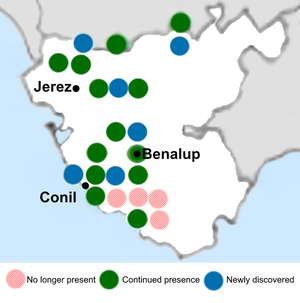 Bustards Not having been able to explore the area for in spring for several years when I returned to Alcala de los Gazules I set myself various ornithological targets. One major objective was to check on Little Bustard population near Benalup. This species has undergone a catastrophic decline in recent years with numbers in its 'heartlands' tumbling rapidly. According to the most recent national atlas the number of breeding males fell by almost half between 2005 and 2011. The position seems particularly critical in Castile-Leon (esp. in Zamora) and I've found them much harder to find around Osuna (Seville) in recent years. I've heard nothing to suppose the decline has halted. Yet in Cadiz province the number of surveyed squares that had lost the species as a breeding bird (4) is counterbalanced by squares where they seem to have been gained (5 - excluding a square the straddles the border) and in over twice that number they have persisted since earlier atlases. However, I suspect the densities in some of these areas must be low. I've looked for them around Jerez and Conil without success (see my map adapted from the most recent Spanish Atlas - see https://atlasaves.seo.org/ave/sison-comun/). 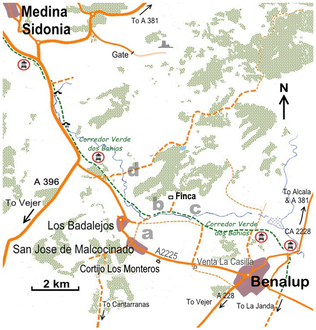 Although I first saw Little Bustard a little closer to Benalup, for some years the area around Los Badelejos has been my go-to site for them for the past decade. More specifically, I found the slope above a junction of several tracks (a on my map) very reliable for them and often found birds calling as I got out of my car. However, in early March and mid-April this year I failed to find them here despite several visits. This made me even more concerned about their future here but I returned later in April to explore further along the valley. Although they were still absent at (a), two farmworkers (to whom I played the call and showed illustrations of the species) were able to confirm that the sisons were still present in the valley. Ten minutes later, I was scanning the slope at (b) when a Little Bustard started to call and after carefully checking the hillside I spotted a single male. The arrival of my friend Chris Cox meant that on 02/05 I had another look at this site. Once again I found no birds at (a) and disappointingly the bird at (b) was silent. Determined to find the birds, Chris and I walked along the Corredor Verde dos Bahias for c1 km beyond the track to the finca (c) but to no avail. As we turned back towards the car I spotted two 'Mallards' out of the corner of my eye but as I raised my binoculars to check I realised that they were actually a pair of Little Bustards! As the male chased the female over our heads and away towards Benalup, a third bird, a male, rose up from the fields and joined the chase flicking his head up as he did so. Result! As we turned back towards the car I spotted a further two male bustards flying over the field at (b). Five birds is the most I've ever seen at this site so perhaps a little cautious optimism about their future here is warranted. 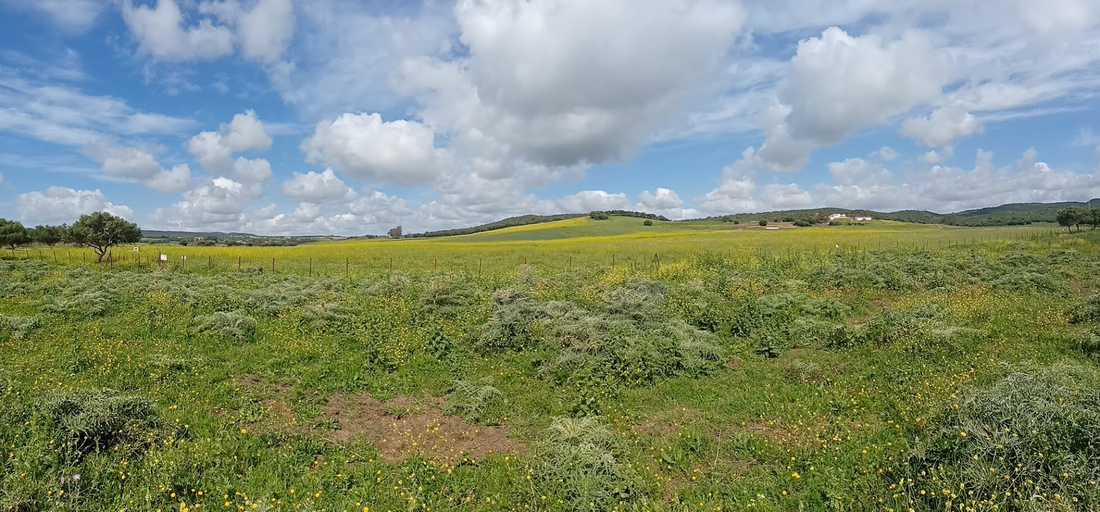 Little Bustard habitat at (b) Little Bustard habitat at (b) Click here to edit. It wasn't all good news as, despite several visits to my alternative site (d) along the Caňada del Valcargo (signposted Valcargado), I failed to find Little Bustard there (although that doesn't mean that they're not present as I've found them elusive here before . 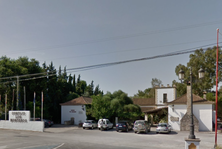 Breakfasts I confess that when out in Spain I often skip breakfast in my keenness to get out birding asap. Then, if the birding's good, I tend to forget about lunch too until it's too late to bother. However, when I'm out early in the morning and the weather takes a change for the worse or it's too misty to see the birds, I am often tempted by having the 'standard' Spanish breakfast - a tostada. I've done so several times at Venta La Casilla as it's convenient for the track opposite which leads to an area that sometimes has Little Bustard. It's very much a working man's venta and if you order a tostada you get the usual round of toast with small foil containers of pate, olive oil or a small dish of 'tomate' (mashed tomato with oil & garlic). However, in April when I found the valley at Los Badalejos swathed in mist and decided to have an atypical breakfast stop I opted to go upmarket and try the Cortijo de los Monteros. Unusually, I'd eaten there at lunchtime several times and always found the food excellent but didn't really expect anything other than the usual fare for my breakfast. I was so wrong! The first clue that I was in for something different was when the waiter appeared with a large tray rather than a small plate. The waiter proudly told me that the bread had been baked that morning by his uncle and that he'd come out with a second slice of toast later so that it too was warm when I ate it. He then loaded my table with a plate on which there were two pates and a dollop of manteca colorá (pork dripping flavoured with paprika), two scoops of more dripping of some sort (both laden with meat), a dish of Spanish stew (chorizo, black pudding, etc) and a dish of calves' liver. It would have been more than enough for two and I struggled to eat less than half (declining the second slice of toast). I expected a hefty bill but I was charged only about a € more than the usual price of €2.50 - €3.00 and rather less than you'd pay in touristy areas (plus €1.20 for coffee). So if you try for Little Bustards early one morning and then feel peckish you know where to go (unless you're a vegetarian who, presumably, starve at breakfast in Spain!) On my short visit to the province in March I was a little concerned that there was no sign of egrets, herons or Glossy Ibis at the usual nesting site on La Janda. Although Cattle Egrets, the dominant species here, only start to lay eggs in late April/early May, there's usually some activity here by March. My concern turned to alarm when I returned in late April to find that the huge heronry was still bereft of birds. This colony has been the highlight of any spring/early summer jaunt to La Janda for years. I'm sure that better informed people than me will know why it has been deserted but I suspect that its failure is likely to be connected with the exceptionally dry winter. However, I doubt that the absence of the egrets here means they're not breeding at all. Although egret colonies seem to persist in the same place over many years, like gulls and terns, birds may shift elsewhere if things aren't quite right. This appears to have happened to the egret colony that once nested in the reedbed near the Bald Ibis colony below Vejer de la Frontera and the unique cliff-nesting egret colony which the ibis were expected to join near Barbate. 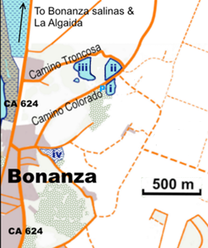 There do seem to be some new, albeit much smaller, colonies of Cattle Egret in the province. For example, there now seems to be one in the trees along the Rio Barbate below my house in Alcala de los Gazules. Unfortunately, its on private land so I was unable to approach closely enough to prove it but from my terrace I could see that, unusually, birds were present in the trees pretty much all day. A second colony has also been established at Bonanza Pools (aka Lagunas de Camino Colorado) although, to be honest, I can't be 100% certain that this colony hasn't been present for rather longer. A combination of my enforced absence from Spain and plain idleness means that I've not actually looked at the third laguna here (iii on the map) for several years. The fact is that my main target here, White-headed Duck, is very easy to see on lagunas (i) and (ii) as are other attractions like Purple Swamphen and, more infrequently, birds like Little Bittern and Marbled Duck. Hence I've rarely bothered to check the third laguna and only did so in April because my keen young correspondent, Bruno Asencio Sevillano, had tipped me off about it. The Camino Truncosa allows good views of the colony which, as expected, consists largely of Cattle Egret but also a sprinkling of Squacco and Night Herons, Little Egret and Glossy Ibis. My total of 31 White-headed Duck which was far better than my combined tally at better known sites such as Laguna de Tarelo and Laguna de Medina which confirms the importance of this once neglected site. I failed to find the Red-knobbed Coot here but having seen one elsewhere didn't try too hard. It was good to see the water level so high here too after the low levels I found in March (see photos) Valdeinfierno In the past the Valdeinfierno sendero (just off the A381 via the service road) has been one of the most convenient sites in the area to look for Iberian Chiffchaff. Here you had two options; park at the start of the track or drive c2km along a generally good track took you to a second small car park from which there was a boardwalk into a small canuto (a narrow, wooded and steep sided valley-within-a-valley). The boardwalk was designed to be wheelchair friendly and the signage even had descriptions in braille. Although you could hear Iberian Chiffchaff (and Bonelli's Warbler) en route, they particularly like the copse-like vegetation along the stream so were pretty much unmissable here in spring and early summer. Unfortunately, the track is now gated (see photo) so driving further into the valley is no longer an option. Pedestrian access seems to be permitted, however, but it's now a 2 km walk along the track to reach the prime area for Iberian Chiffchaffs. However, unless access has changed, you should still be able to drop down into the valley bottom after c800m by using a gated footpath on your right and follow the stream up to the boardwalk. Picacho-Peguera Walk This is another good walk off the service road into the woodland. In the past, there was room for only a couple of cars to park off the road here and many people illicitly parked beyond the gate. However large stones now prevent this and, besides, there's now a good sized car park across the road. The sign on the gate warning you to be beware of fighting bulls has now gone being replaced by injunctions not to collect pine cones (GoogleTranslate insisted on "pineapples"!) or drive along the road. This site also has Bonelli's Warbler but rather fewer Iberian Chiffchaff. 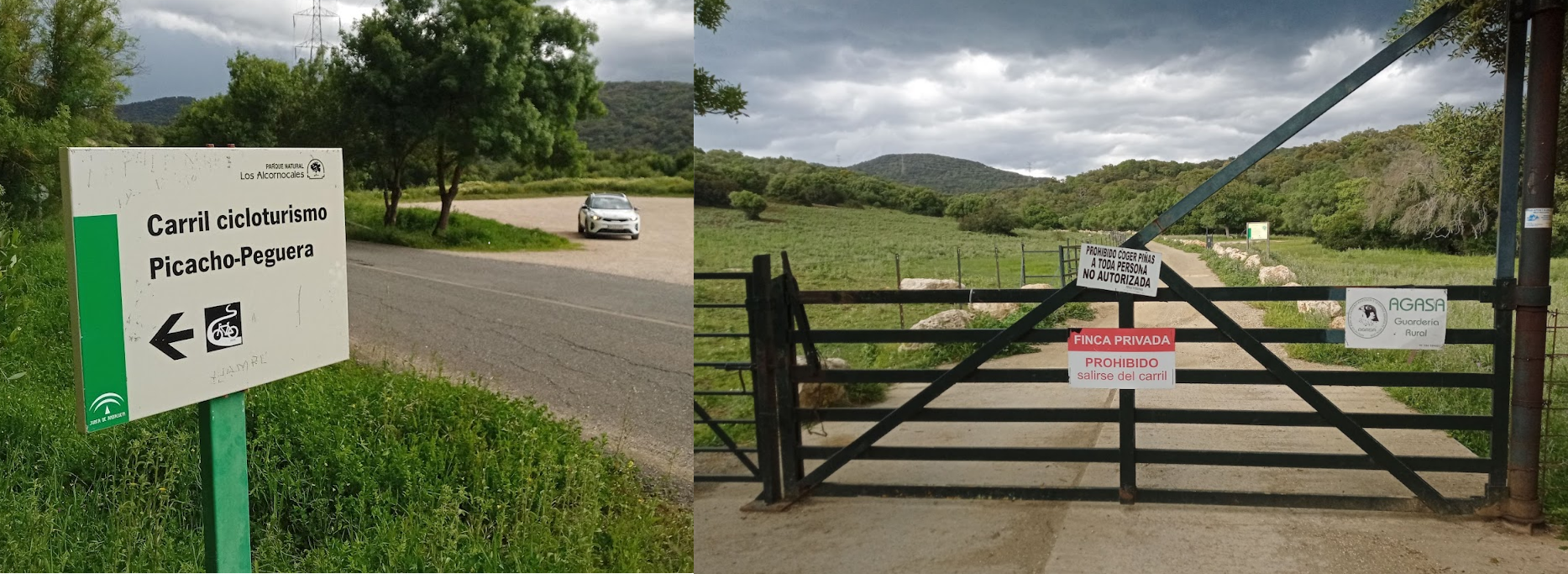 Area Recreativa Montera del Torero On the rare occasions in the past when I've stopped here (I prefer the Valdeinfierno nearby), this site has been awash with noisy picnickers so I've avoided it. However, it's not always so and probably pays further investigation. 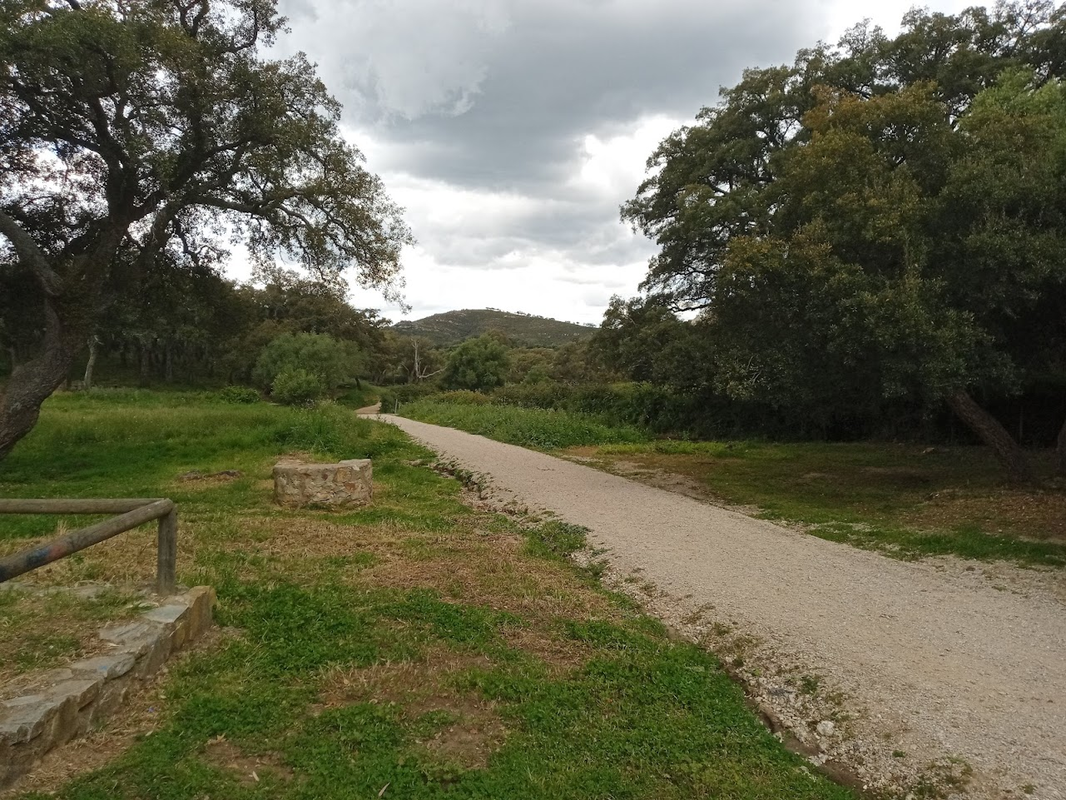 A quiet day at the Area Recreativa A quiet day at the Area Recreativa Click here to edit. Molinos Valley, Alcala de los Gazules I need little excuse to post a few photos from one of my favourite walks. This spring the walk was a particularly pleasant one and the 'hidden' pool above the last mill hadn't dried out. The downside, though, was that the stream across the footpath was in full spate and required great care (and a walking pole) to cross safely. I also belatedly discovered that it was possible to follow the path beyond the pool back to the main path near the stream. This turning isn't at all obvious from the main path. Whether it is a public footpath I'm unsure but it certainly looks well used. This route has Bonelli's Warbler, Iberian Chiffchaff and often channels raptor passage. I've also recorded resident raptor species such as Bonelli's and Spanish Imperial Eagles here. I decided to fly into and out of Aeropuerto de Seville largely because I wanted to see Azure-winged Magpies at Parque Oromana in Alcala de Guadaira but also to revisit Humedal El Pantano and check Laguna de la Mejorada which I hadn't visited at all for several years. Accordingly, I booked into Hotel Oromana the night before my flight home so that I could explore the latter two sites en route and the parque on arrival and the following morning. 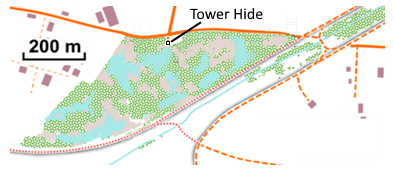 Humedal El Pantano On my previous visit in March the 'swamp' (the literal translation of 'pantano') was, like most wetlands in Andalucia, very dry with most 'pools' were little more than mud-pans. As the photos below indicate, this time the situation was very different with scarcely any exposed mud and all the pools full to the brim. The other obvious difference was the sheer number of birds particularly Glossy Ibis. The latter were breeding in the swamp but with so much action with birds flying to and fro the exact number present was difficult to judge - I got to about 200 birds before realising an accurate count was impossible. Similarly, it was difficult to judge the number of Purple Heron and Little Bittern present as it was difficult to avoid double counting flying birds but I settled for a modest total of seven for the former and three for the latter making it one of the easiest sites for seeing these skulking species. Also present were 13 Spoonbill and a sprinkling of Little and Cattle Egrets and Night Herons. Ducks too were well represented with Mallard, a dozen Pochard, a couple of Red-crested Pochard and a few Shoveler. Waders included Black-winged Stilt, a pair of Little Ringed Plover, Pratincole, Common Sandpiper and Snipe. Amongst the noisy sixty odd Black-headed Gull were 18+ Whiskered Tern (both breeding here). In short, when wet It's an even better site for a quick detour from a journey along the AP4/E5 Seville-Cadiz motorway. 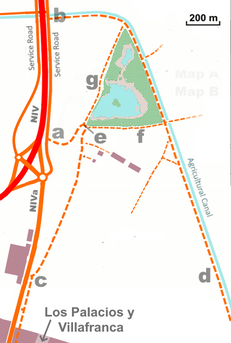 Laguna la Mejorada Despite being the better known site, I found Laguna la Mejorada much less productive for birds than the nearby Humedal El Pantano although it did have more Whiskered Terns (38). The nearby NIV and its junctions have changed since my last visit and the tracks around this site have been improved and upgraded. There are several routes to the Laguna de Mejorada. If arriving from the NIV you can turn north at the roundabout onto the service road and then first right (a) along a narrow track shrouded by tamarisks. If you miss this turning you can continue along the road and take the track (b) next to the canal. Alternatively, if coming from Los Palacios on the NIVa take the track opposite the Puegot dealership (c) which is c1km from the final roundabout in Los Palacios (or c1 km south of the junction with the NIV). If you want to avoid the drive through Los Palacios from the AP4/E5 then take the road (d) along the agricultural canal (see Google maps or my guide for details). Most of the laguna is completely shrouded by dense undergrowth on two sides but views can be obtained from the south-west corner of the laguna (e). If looking for Olivaceous Warbler try walking along the track (f) linking the canal and checking the tamarisk as you go. Views can also be gained from the rough track (g) running along the western edge of the laguna. 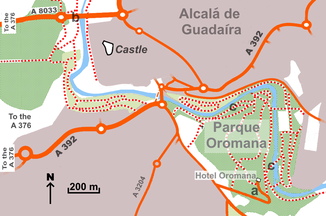 Parque Oromana, Alcala de Guadaira As already noted the main purpose of this detour on the route home was to see Azure-winged Magpie (or 'Iberian Magpie') which I'd not seen for several years despite looking in Algaida pines many times. Hence, I'm very grateful to Gordon Shaw for bringing this site to my attention. Finding them proved even easier than I'd anticipated as I saw several birds as I drove up through the pines to Hotel Oromana(a). That afternoon I walked through the park to the Dragon Bridge (b) but only found Azure-winged Magpie in the open pinewoods near the hotel. Fortunately, they were very easy to find in that area and down to the children's playground below the hotel. Also present in these open pine woods were Golden Oriole and Hoopoe. That evening and again the next morning, I had a look at the riverside woodland (c). Here I found, amongst others, Olivaceous Warbler and Iberian Green Woodpecker. I studiously tried to ignore the parakeets squawking in the trees assuming that they were Monk Parakeets (ubiquitous in many parks in Spain) but when I bothered to look I found that they were actually Rose-ringed Parakeets. The lower part of the park drops down to the Rio Guadaira whose course is punctuated by a series of weirs attended by old mills reflecting the town's heritage as the main supplier of bread to nearby Seville. Although the park was very attractive, the rest of Alcala de Guadaira was an acute disappointment as most of the buildings are relatively new and characterless as befits a growing dormitory town for Seville. If there was an historic centre I never found it and it also proved difficult to find a walking route up to the fine Moorish castle. This was just as well as it transpired that the castle was closed. Worse still, when I sought directions I was warned not to walk up towards it as "bad people" live there and I'd be mugged - something I've never been warned about previously in Spain! So, after a pottering around the park in the morning, I opted to take the 25 minute drive to Carmona for lunch before flying back to the UK in the late afternoon. In contrast, Carmona is a magical small town with a fine architectural heritage and a long history. Only the determined ornitho-philistine could fail to be impressed by the town's heritage! Laguna de Medina For most birders visiting Cadiz province, "lagunas" means checking Laguna de Medina to see White-headed Duck and, with luck, Red-knobbed Coot plus the hope of seeing Ferruginous or Marbled Duck or, more recently, Olivaceous Warbler. To be fair, as its sited just off the fast A 381 near Jerez (into which many will fly), is relatively easy to scan and rarely dries out (unlike other lagunas) this makes a lot of sense. In March this year, after a long dry winter, I thought 2022 would be one of those rare 'dry' years when the 'laguna' becomes a shallow depression of sun-baked mud. The water level was even lower than I've seen it in August when one might expect the water level to be very low following the driest months of summer. However, by May, thanks to some heavy rain in late March/April, it was pretty much full. Visits in late April this year produced 700+ Flamingo, a single Red-knobbed Coot, 2 Marbled Duck, 2 White-headed Duck, 112 Red-crested Pochard (a good count according to e-Bird) and a good assortment of waders including 50+ Ringed Plover, 5+ Little Ringed Plover, 2 Lapwing, 3 Black-tailed Godwit, 2 Ruff, and a 70+ small waders (mostly to far away to identify with absolute confidence but those that were nearby below the hide consisted of 9 Curlew Sandpiper, 3 Dunlin and 2 Little Stint). Luckier observers had a Pectoral Sandpiper drop in. Unfortunately, most small waders here tuck themselves into the corner of the laguna 500-600m from (and at a difficult angle to) the hide so only birds that drop onto the thin strip of mud in front of the hide can be easily identified. It's a pity there's not a second better placed hide to view this corner. It was disappointing to find only a couple of White-headed Ducks confirming that 'Bonanza Pools' are by far the best place to look for this target species. Perhaps the recent drought conditions are responsible for this poor showing although the occasional drought helps in the long term by excluding colonisation by carp. It was also interesting to take a closer look at the series of small lagunas in a small quarry just north of the reserve. These have presumably been developed as some sort of "mitigation" by the nearby cement factory. They can be viewed from the service road but hopefully some sort of formal access may be arranged and a path (circled in red in the GoogleEarth image below) looks like it's meant to connect with the main reserve. They held no more than large numbers of Yellow-legged Gull, a few Red-crested Pochard and Little Ringed Plover but may be worth keeping an eye on. . Lagunas de Puerto Real In addition to their relative obscurity and poor access, some of the other lagunas in the area suffer from what, frankly, seems to be neglect. Some, for example, like the Lagunas de Espera have ill-sited hides now entirely (or almost entirely) obscured by vegetation but most have no provision for the public to see and enjoy the birdlife at all. One example of both problems are the three lagunas that make up the Lagunas de Puerto Real. Laguna de Comisario is the largest and potentially the best but, although I didn't stop there this May, checking on GoogleEarth it still seems inaccessible (or legitimately so). Laguna de San Antonio has always been completely overgrown but when I first looked at Laguna de Taraje I called it a 'hidden gem'. You could still get a decent view across much of the laguna from the track and there was a reasonably large stretch of open water that attracted wildfowl. However, when I looked at the site this May I found it almost entirely choked with vegetation with only a small area of open water suggesting its heading the same way as the Laguna de San Antonio. Admittedly, such a long dry winter it's probably drier than usual but without restorative work the laguna will surely join others in the area and disappear. With the track to the laguna now in a very poor condition, the only reason to visit the site is to slake your curiosity. 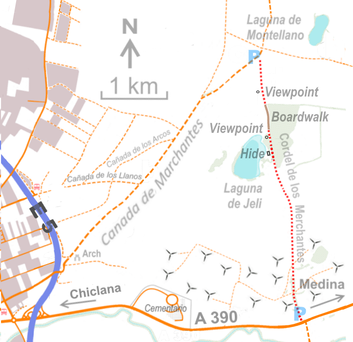 Laguna de Jeli Yet my growing pessimism ebbed considerably after a visit to the Laguna de Jeli. This is another site too long ignored by birders because it's less well-known than Laguna de Medina and less convenient to visit (although a good deal easier than most imagine). Over a decade ago when I first tried to visit the laguna I couldn't find the path from the A 390 (Chiclana - Medina Sidonia road) by which it was supposed to be accessed. This was a forgivable oversight as the path was then narrow, badly overgrown and un-signposted with nowhere to pull-off on the main road. How things change! As one of the slides below shows, the footpath (Cordel de los Merchantes) is now very well-signposted on the A 390 (although you have to stop to find out where it goes) with a convenient car park. However, long before the path to Laguna de Jeli was upgraded I searched for an alternative easier route to the reserve and, thanks to GoogleEarth, discovered an excellent wide gravel track, the Cañada de Marchantes, which takes you to the other end of the path. Not only does this route reduce the walk to the laguna from almost 3 km to half that distance, it's also worth checking in its own right. The cañada follows a ridge with good views towards Medina to the east and the Bahai de Cadiz in the west. I've had both Montagu's Harrier and Black-winged Kite here and during migration periods small groups of Honey Buzzards and other raptors drift over. Other birds such as hirundines, Roller and Short-toed Lark also seem to follow the ridge. Better still, the surrounding low intensity agricultural plots hold Rufous Bushchat. So, although it means a 10 km detour to the footpath (if arriving via the car park on the A390), it's one that's well worth it even before you get there. Walking along the footpath you quickly reach an information board and viewpoint which gave scenic views of the laguna c1 km away. Unfortunately, in the past as you continued along the view became entirely obscured by thick bushes and, just to complicate things, the path could be very muddy after rain. However, on my recent visit I was pleased to discover that much work had been done to improve matters. The first improvement was a 350m long boardwalk through the bushes which raised up high enough to see over the bushes. This was followed by another viewpoint that finally gave you a useful view of the laguna and then a slatted hide that overlooks the nearest edge of the laguna. (I suspect that the boardwalk, hide and viewpoints may have been financed as a mitigation measure for the large windfarm nearby. It's a shame that nearby Laguna de Montellano hasn't been given a 'facelift' too since viewing it remains very difficult). The hide might be further away than ideal (c150-200m depending on water levels) but, if you have a 'scope, you should be able to identify most of the wildfowl here which, with White-headed, Ferruginous and Marbled Ducks potentially on the 'menu', could be worth the walk. So, unlike Laguna de Taraje, Laguna de Jeli remains a 'hidden gem' well worth seeking out and exploring. Even if the laguna is quiet and relatively birdless, this is a great area with much potential for a visiting birder to find something for themselves.
The vast intertidal mudflats, marshes and salinas of the Bahía de Cádiz may be good habitat for numerous waders, gulls, terns, etc but for the birdwatcher getting into the habitat to obtaining satisfactory views of the birds (even with a 'scope) can be problematical. Large obvious birds like Flamingo aren't a challenge and even Slender-billed Gulls can be picked out at long range with experience but most of the smaller waders are often be too distant for confident identification and some small birds found in the saltmarsh simply impossible to see. However, as the Laguna de Medina - a popular stop for birders - is relatively close-by, a decade or so I go I investigated the area along the CA 3113 with a view to finding a location for gulls, shorebirds and particularly Lesser Short-toed Lark and Spectacled Warbler rather closer than the Bonanza area (c50 minutes from the laguna). A bonus, in some ways a dubious one, was finding that the large rubbish tip (a) was a magnet for Black Kites and even on one occasion, attracted an Eagle Owl. I quickly found all of my targets could be seen along the track into Salinas Santa Maria (b). However, this site wasn't 100% reliable for these species, had few(distant) waders and regular passing heavy lorries (which pick up a veritable dust storm when the track is dry) could make viewing less than ideal. Having checked for tracks into the marismas via GoogleEarth, my next stop was the Pinar de la Dhesa de las Yeguas (c) about 25 minutes drive from the Laguna de Medina. Whilst the woods looked attractive and had plenty of places to park, the track into the marsh was in an appalling state. So I earmarked as somewhere to visit at a later date when it wasn't so hot (it was mid-afternoon in August on that first visit) or when the track was in a better state. Unfortunately, a change in my personal circumstances delayed my next visit until spring 2019 when I found the track in a good condition and that the area was now a reserve but gated and access limited to those with a permit. This was hugely frustrating as I could see that this was a site with great potential. Nonetheless I was keen to revisit this site when Covid restrictions were lifted and somehow, despite my poor Spanish, obtain a permit. I even tried, unsuccessfully, to persuade the authorities to provide an email address by which a permit could be obtained rather than by phone (which required excellent command of Spanish). So when a local correspondent, keen young birder Bruno Asencio Sevilano, informed me that access was now free to pedestrians without a permit, visiting this site in April/May 2022 became my priority. I wasn't disappointed! I've looked at the Pinar de la Dhesa de las Yeguas (c), an attractive open pine woodland with picnic tables and plenty of parking, several times in the past and had already concluded that it was likely that this area of relatively isolated woodland might hold good numbers of migrants in spring. This seems to have been confirmed by the large numbers of Spotted Flycatchers (plus a sprinkling of Pied) I found here. It also has the added attraction of holding both Great-spotted and Iberian Green Woodpecker (a species that has greatly increased in the province). It also has numerous Serin and, given their current scarcity in SE England, I was delighted to find Greenfinch particularly numerous here. Despite the disturbance the site suffers at at weekends, an evening visit in summer should produce Red-necked Nightjar (5+ seen in one evening visit recently). 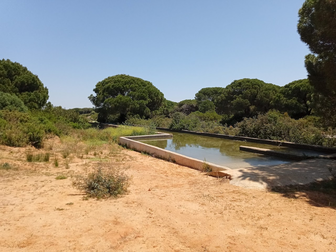 The feeder tank by the road at the NE end of the Dhesa de las Yeguas The feeder tank by the road at the NE end of the Dhesa de las Yeguas An additional bonus here for those with sharp eyes and, more particularly good hearing, is Savi's Warbler. This species is very sparsely distributed in Spain although the lower Guadalquivir (i.e. Brazo del Este and the Coto Donana) seems to be a hotspot for them. According to the most recent Spanish atlas, they're now absent in this the only regular site I know for them in Cadiz Province. However, up to three reeling birds were found in 2019 and at least one bird was present (although hard to see) in 2022. The best approach is to get there as early as possible, take the track to the right which runs parallel to the CA 3113 and walk along the path (d) following margins of the dry reedbed (optimistically called Laguna de Cetina on some maps). The edge of the wood is also good for migrants whilst Black Kites and Marsh Harriers are usually obvious above the marsh. Multiple paths here take you into the woods and back to the main track but don't neglect the small agricultural aqueduct and feeder tank just beyond the car park by the road as this attracts birds coming down to drink. If you've not got a permit then there's space for several cars to pull off near the gate (e) although in hot weather you might prefer to return to a cooler car and pull off in the shade of the nearest trees. The trade off is that you then have to walk the last c750m. In this context, note that this site is very exposed to the sun with no shade (other than the two hides) so take some water and wear appropriate clothing if you intend to explore the site. 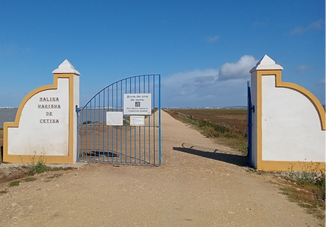 The open gate has a smaller one inserted for pedestrian access. The open gate has a smaller one inserted for pedestrian access. On reaching the gates take care as you enter the reserve since the corner of the large evaporation pool on your left often has a muddy margin attractive to waders (in early May I had Dunlin, Sanderling, Curlew Sandpiper and Little Stint all in a single field of view here). Hopefully, with a little fieldcraft you should be able to enter and obtain good views of any birds. Raising your binoculars a tad and scanning further over the area Flamingos should be immediately apparent with smaller dots quickly resolving themselves to be Black-winged Stilt and Avocets. Taking a closer look at the gulls (preferably with a 'scope) should quickly reveal some Slender-billed Gulls. On my visits this spring I also had a Little Gull here so it's worth spending some time checking through the 'larids'. To your right (f) there's an extensive area of mud supporting a light growth of low halophytic plants. Both here and across the site this habitat is home to Lesser Short-toed Lark; in my experience this is by far the easiest site to catch up with this species in the province. (Greater) Short-toed Lark can also be found here albeit in much lower numbers (and only in summer). Also present in this habitat are Iberian Yellow Wagtail, Kentish Plover and Collared Pratincole (although the latter are more likely to be seen, or heard, long before you spot their mud-coloured forms half-concealed in the vegetation. About 550m from the gate there’s an open-backed hide (g) that provides useful respite from the sun and shelter from the rain. It’s functionality as a hide is somewhat compromised as it faces back towards the way you’ve come so you’re liable to flush birds as you approach but it’s a handy place to stop to scan the salinas for anything you may have missed. There's a good chance of spotting an Osprey (or two) here whilst careful scrutiny of the birds across the vast open water could well throw up Spoonbill (and perhaps Great-white Egret which is increasingly frequent in the province). A further c750m along the track takes you to a second hide (h) which also faces back down the track from which you can again scan over the salinas. On my visit this spring, the small pools along the right-hand side of the track between (g) and (h) seemed particularly productive for small waders so scan these before you head towards the second hide. 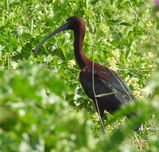 If, instead of heading towards the next hide, you take the track to the right after c170m you pass a small pool to the right (i) which can hold more waders plus Glossy Ibis, Purple Swamphen and Purple Heron (although you've got a good chance of seeing all three before you reach this spot). Continuing along this path there are various small pools to the left and right (j) which can harbour still more waders. The latter may include breeding Lapwing which is a relatively scarce bird in the province . As always, as you proceed check for passing raptors (Marsh & Montagu’s Harriers, Booted Eagle, Black Kite, etc) and distant Griffon Vultures but be prepared for surprises, an imm. Bonelli's Eagle was seen here on the day I visited in late April. 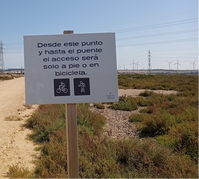 Spectacled Warbler habitat behind & to the right of the sign Spectacled Warbler habitat behind & to the right of the sign About 1.5 km along this track from the hide you reach an area of thicker, taller vegetation bordered by a small ditch. The map on the sign at the start of the reserve suggest this is the end of the footpath but another sign here suggests you can walk further (although this is doubtfully worthwhile as ornithologically dull commercial salinas start here). Don't ignore the taller vegetation beyond and to the right of the sign as this is the haunt of Spectacled Warbler, the last of the special passerines to be found here. This diminutive version of Common Whitethroat is an attractive species well-worth the 3 km round trip from the hide. You may need some patience to spot one since unless they're singing and/or song flighting they can be hard to spot in the dense vegetation. The excellence of this site is reflected in the growing number of e-Bird reports (528 at the time of writing, sixty more than in March) and the number of species recorded here (currently 198) - see https://ebird.org/hotspot/L6443288 - which compares favourably with the well-established Salinas de Bonanza which has fewer than twenty more species recorded despite not far short of twice as many trip reports over a much longer time span. Including the nearby woodland, it probably also has a better variety of species close at hand. With access to the better parts of the Salinas de Bonanza now restricted, the Marisma de Cetina is now, arguably, the better site to pick up waders and other specialities of salinas. In the brief period that access has been permitted it's racked up a good list of rarities which in spring 2022 alone included Western Reef Heron & White-winged Black Tern. As suggested earlier, a visit combining a look at this site with one to Laguna de Medina would make for some very productive birding.
No visit to this part of Spain, particularly in late spring, is complete without a look around the Trebujena area for Rufous Bushchat. It's a species in serious decline with a 95% reduction in numbers across the country, extinction in Granada and nearly so in Alicante and Murcia (98% reduction). Fortunately, as I've noted before a good population persists in the vineyards around this small town. I wasn't absolutely confident that I'd see one on my fist visit here this spring on 03/05 as birds sometimes arrive as late as June. Happily, I found a singing bird at the first place I checked (which was about 400m from where I'd had a pair with young last autumn). A check at the latter site was unproductive but a look at a third location produced a second bird. 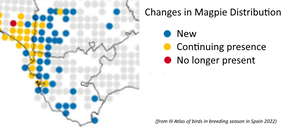 My second visit to Trebujena was on 07/05 for another iconic and even trickier species to see in this area - Pin-tailed Sandgrouse. So tricky, in fact, that I'd only seen them once myself (although that's partly because Liz was always reluctant to get up early enough or stay late enough to give a good chance of seeing this species which tends to be most active at dawn and dusk). That said, I've known keen birders who've tried to find them multiple times without any luck. A few days before my visit, I'd tipped off a young Dutch birder, Danny Bregman, where to look and was somewhat miffed to hear that he then saw a couple on his first attempt! Hence I was up before first light to drive up to the area north of the A471 and c4km west of Trebujena where he'd seen them. It's a good area so I wasn't surprised to find Short-toed Lark, Montagu's Harrier, Spoonbill, etc with relative ease but what was a surprise was an adult Great-spotted Cuckoo happily feeding along the track! As this is largely a migrant in Cadiz province (and at a time I'm often back in the UK), I don't often see them and this bird treated me to my best views of the species. A 'result' but not the one that I expected. (NB - This saved me a trip to the area north of Puerto Real (Las Aletas) where the species now seem to be regular visitors, perhaps related to the increase in the Magpie, which they parasitise, in that area. 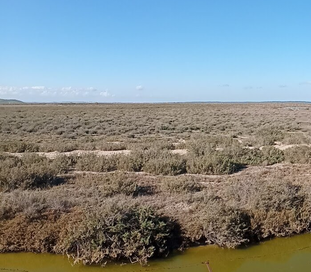 Excellent although it was to catch up with the cuckoo, I still hadn't seen any sandgrouse. I searched for another hour or so without any luck and as the habitat didn't look quite so good as that at Cortijo de Alventus (NW of Trebujena and c1km from the Guadalquivir). I knew that they were present in that area as I'd missed them by minutes in March. So 15 minutes later, I was just getting out of my car on the track by the cortijo when I espied a distant flock of twenty-plus sharp-winged fast flying birds. I quickly got my binoculars on them and, despite the distance, the two birds I concentrated on were clearly Pin-tailed Sandgrouse! In fact, to my great surprise, I could even hear their distinctive gaaa-gaaa call (hence the Spanish name Ganga). I didn't really take in what all the birds were but twenty seemed an awful lot for this scarce species, so I kept scanning for a more conclusive view. However, all I could find were flighty flocks of Grey Plovers (at least 60 and probably more), some in summer plumage, some in winter plumage and many moulting between the two. Sandgrouse resemble Golden/Grey Plovers in flight and the birds I saw were very distant so after fifteen minutes the doubts started to creep in - had I really seen them or was I just desperate to see them? Could I really have heard their gaaa-gaaa call at that range or was it me who was going gaga? I was on the brink of discarding the record as the result of delusional overenthusiasm when I heard a much louder gaaa-gaaa, looked up and had two Pin-tailed Sandgrouse fly right above my head before zooming off towards the site I'd first tried. Phew! With hindsight I think that, although I'm confident that I did see two birds earlier, I probably heard closer birds which I failed to see. I've since discovered via e-Bird that the following day two other observers, Faustino Chamizo Ragel & Chúss Fernández Vélez, had 35 sandgrouse (plus 125 Grey Plovers) on the Marismas de Trebujena (which seems to be the generic name for the whole area). Hopefully, this, the highest count here for some years, may reflect the work in restoring the marismas in recent years. So, despite my pessimism perhaps that original flock were all sandgrouse after all! Buoyed up by my success and as it was still relatively early, I decided have another look for bushchats and then visit Marisma de Cetina on my way back to Alcala. This time, as I was arriving from the opposite direction, I tried my third RBC site first. When I got there I pulled off next to a minibus and just as I got out of the car a group of four birders appeared from the other side of the road. Speaking to their guide, Stefan Schlick, I discovered that they were from Oregon and had been looking, unsuccessfully, for Rufous Bushchat. What could I do other than show them where I'd seen the birds in the past? After a couple of false starts, we pulled off where I'd first seen one on 03/05. We got out of the vehicles and, as I pointed out where to look, the bird flew past us singing! Only having previously seen them sing from a perch, I hadn't realised that they also do so in flight! We all subsequently had fantastic 'scope views! Brilliant stuff! It transpired that Stefan had used an old version of my site guide in planning his trip so he asked me where his group might see Red-knobbed Coot and some waders. I suggested Laguna de Medina for the first and Marisma de Cetina - which he'd never heard of - for the second. My offer to show them both sites was quickly taken up but first the group kindly insisted on buying me lunch. Medina proved to be a disappointment but Cetina delivered the waders some of which (Dunlin, Grey Plover, etc) are commonly found in America but others like Little Stint and particularly Lapwing were most appreciated. The Little Gull I'd seen here previously was also present amongst the Slender-billed Gull. More expected were Lesser Short-toed Lark which they hadn't seen previously. Showing people the delights of the area and a clutch of new birds was a bonus and a delightful way to spend my day ... without actually changing any of my plans!
Just about the only downside to being a birder based in Alcala de los Gazules in Cadiz Province is that Azure-winged Magpie are very elusive and hard to see in that province. The only place they are said to occur regularly is in Algaida pinewoods near Sanlucar. I have indeed seen them there but very infrequently and I know others who've looked several times without any luck. Yet just across the Guadalquivir on the Coto Donana they're usually easy to find. So any hope of seeing them when staying in the area involves driving up to Seville and then down to El Rocio, a round trip of almost 5 hours. Other less certain sites in the Sierra Norte or in the north-east Malaga will take almost as long. I was updating my notes and writing up any changes when I had an email from Gordon Shaw for tipping me off about a colony in Alcalá de Guadaíra, a mere 90 minutes away from my base in Alcalá de los Gazules (there are many "alcalás" as it means 'stronghold' in Arabic). Better still this site is only 20 minutes from Aeropuerto de Sevilla (into which I often fly) and only a 10 minute detour off the SE 40 as you head south. A quick check of the Atlas de las Aves Reproductoras de España (Pub. 2004) confirmed that this population hadn't been reported twenty-odd years ago. However, with the release online of the latest Spanish bird atlas (III Atlas Aves - see https://atlasaves.seo.org/ and below) it's clear that the population had been established at the time of the new survey (2014-2017). The new atlas appears to show a mixed picture with populations now established on the east bank of the Guadalquivir but also missing in large areas of Huelva province. Does this apparent absence reflect a decline in population or poorer survey work? So, I checked the maps on eBird and I found that the eBird map seems to broadly confirm the results of the atlas work. The odd reports of Azure-winged Magpie across northern Huelva, where there's a blank space on the new atlas atlas, seems to mirror to a large degree the route of the N-435 from Extremadura which suggests they're still present, just under-recorded.
Delving more deeply into the reports around on eBird I found fewer than a dozen reports from the immediate vicinity of Sevilla (mainly of 1-2 birds although eight were reported at Parque del Alamillo in 2019). Given the source it's not surprising that most reports are post 2020 (i.e. after the use of eBird increased markedly). Records from Alcalá de Guadaíra are quite different in nature (if not in time frame); the first report on eBird comes from 2018 when 8 were reported and since then the lowest count has been of 3 birds (2021) and the highest of 39 (2022). Gordon reported to me that they were 'common' around his hotel in Parque Oromana and the report in 2018 of 8 birds in the Parque Ribera del Guadaíra (just to the west of the castillo) which suggests a population throughout the stone pine woodland along the Rio Guadaíra Unlike reports in Sevilla this is obviously a secure and perhaps growing population. The nearest other cluster of reports (involving fewer records and fewer birds) is from Carmona to the north-east. It's likely that Azure-winged Magpie were commoner in the lower Guadalquivir valley in the past when more areas were, I'm told, afforested so this may be an overlooked relict population. However, I prefer to think it's a indication that the population is expanding. Either way my chances of seeing this handsome species on my jaunts out to Spain have increased considerably and besides as a retired history teacher I really ought to visit the castillo in Alcalá de Guadaíra as it's said to be the finest Moorish fortification in Spain. |
About me ...Hi I'm John Cantelo. I've been birding seriously since the 1960s when I met up with some like minded folks (all of us are still birding!) at Taunton's School in Southampton. I have lived in Kent , where I taught History and Sociology, since the late 1970s. In that time I've served on the committees of both my local RSPB group and the county ornithological society (KOS). I have also worked as a part-time field teacher for the RSPB at Dungeness. Having retired I now spend as much time as possible in Alcala de los Gazules in SW Spain. When I'm not birding I edit books for the Crossbill Guides series. CategoriesArchives
May 2023
|